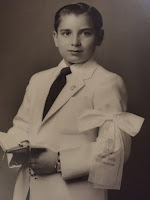Had
it not been for the pandemic, this would have been my last Sunday Mass at
Immaculate Conception. But then came COVID-19, and as a result I am still here
– for another 6 months anyway.
Coming
and going is, sadly, an occupational hazard of priestly life, particularly in
religious communities. It is a hazard because, generally speaking, people are
healthier and happier the more stable and less disrupted their lives are.
Jesus was obviously a disruptor, intentionally so. Even so, he certainly understood that he was asking a lot of his apostles. Having himself as a child been a political refugee from Herod’s terror, Jesus would have directly experienced the stress of leaving home and facing an uncertain welcome elsewhere. So he softened his challenging call to embrace instability and disruption a bit by putting in a plug for hospitality. Whoever receives you receives me. … And whoever gives a cup of cold water to one of these little ones to drink – amen, I say to you, he will surely not lose his reward [Matthew 10:37-42].
Jesus was obviously a disruptor, intentionally so. Even so, he certainly understood that he was asking a lot of his apostles. Having himself as a child been a political refugee from Herod’s terror, Jesus would have directly experienced the stress of leaving home and facing an uncertain welcome elsewhere. So he softened his challenging call to embrace instability and disruption a bit by putting in a plug for hospitality. Whoever receives you receives me. … And whoever gives a cup of cold water to one of these little ones to drink – amen, I say to you, he will surely not lose his reward [Matthew 10:37-42].
Jesus’
words reflected the high value in which hospitality and welcoming were held in
his society, something also illustrated in our reading from the Book of Kings [2 Kings 4:8-11, 14-16a]. The
Shunemite woman gave Elisha more than a cup of cold water. She gave him dinner
and a room! In this, she foreshadowed the generous women in the Gospels, like
Martha and Mary, who offered hospitality to Jesus and his disciples, welcoming
them into their home, serving ever since as models for the high spiritual value
the Church has placed on reaching out and welcoming down through the centuries
right up to our own time.
Inspired
by Jesus’ own words in his parable about the Last Judgment, “I was a stranger
and your welcomed me,” Saint Benedict’s Rule for monks famously prescribes that
all guests who present themselves are to be welcomed as if they were Christ
himself. Nor have hospitality and welcoming been confined to monasteries. When
17-year old Annie Moore crossed the threshold of the New World as the first
immigrant to pass through the new Ellis Island immigration Facility on January
1, 1892, she was welcomed by, among others, Father Callahan of the Mission of
Our Lady of the Holy Rosary, who blessed her and gave her a silver coin, a
symbolic expression of hospitality and welcome. Annie Moore’s story – along
with the stories of so many others, among them my own grandparents and the
parents and grandparents of so many of us assembled here today – ought
especially to impress themselves on our consciousness, both as Catholics and as
Americans. For we have always been a Church of migrants and strangers, in more
ways than one. Migrants, strangers, and other marginalized communities have
always been the face of our Church in this country – in our parishes and in our
schools and in our other social ministries.
But,
as we assemble today, as we do every
Sunday, to profess our faith as migrants and strangers passing through this
world en route to our final homeland,
we have been forcefully reminded especially during this past month of
our country’s complicated history, and of our many failures as a country, as a
Church, and as individuals – what the US bishops already 20 years ago described
as “failures of understanding and sinful patterns of chauvinism, prejudice, and
discrimination that deny the unity of the human family, of which the one
baptism is our enduring sign.” [Welcoming The
Stranger Among Us: Unity In Diversity, USCCB, 2000]
As
fallen and sinful human beings, we will always inevitably fall short of Jesus’
challenge to a new way of living, to a new way of being human together. But by
baptism into Christ, we are no longer permitted to be strangers to one another,
for we have been brought beyond the ordinary human limitations of family and race,
and raised instead with Christ to live in newness
of life, responding to one another and welcoming one another as we would
never otherwise have known how to do or dared to have tried.
As
Pope Francis said when he spoke to Congress in 2015: “if we want security, let
us give security; if we want life, let us give life; if we want opportunities,
let us give opportunities. The yardstick we use for others will be the
yardstick which time will use for us.”
Homily for the 13th Sunday in Ordinary Time, Immaculate Conception Church, Knoxville, TN, June 28, 2020.
Homily for the 13th Sunday in Ordinary Time, Immaculate Conception Church, Knoxville, TN, June 28, 2020.













